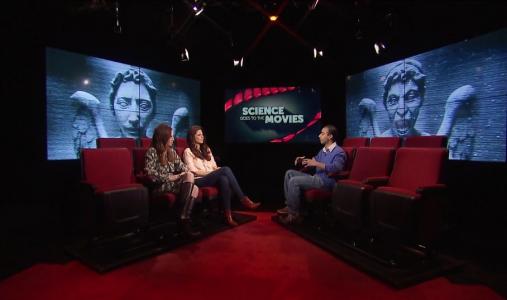
Science Goes To The Movies: Dr Who: Quantum Physicist
No of Episodes: 1CUNY TV (USA):
First Broadcast: Friday 8th April 2016
Running Time: 26 minutes, 45 seconds
In episode #204 of Science Goes to the Movies, series co-hosts Dr. Heather Berlin and Faith Salie are joined by Mukund Vengalattore, atomic physicist and Assistant Professor of Physics at Cornell University, to talk about quantum physics in the British sci-fi show, Dr. Who.
Starting off the discussion is a look at Vengalattore’s well-publicized quantum theory research on a phenomenon very similar to what is seen on Dr. Who from the beings known as “weeping angels.” Vengalattore explains the various tenets of quantum theory, including that a system shouldn’t change while it is being looked at, or measured, which his work aims to elucidate in order to develop a better understanding of how to control a quantum system. Making atoms cold, letting them loose in a contained environment, and carefully watching their movement is explained as a process that leads to the atoms being frozen in place, just like the “weeping angels.”
Wave-particle duality, one of the fundamental concepts of quantum physics, is explored next. In particular Vengalattore breaks down how certain entities are considered delocalized, as in waves that ripple out in every direction, without a particular location or velocity, while others are considered to have specific locations and velocities, and how, according to quantum physics, a single entity may display both sets of attributes at the same time. Whether you see particle or wave-like properties, Vengalattore explains, depends on which of the two you are looking to find, but scientists thus far have not been able to find both simultaneously. These two concepts are described as representative of very different kinds of physics, which is why it is curious to be able to see either type of behavior in the same atom.
The practical application of these principles is considered next, such as in the creation of transistors, computation, and lasers, which were made as a means to measure atom behavior in order to verify quantum theory. Vengalattore offers his take on the way in which a fundamental curiosity about the way nature works can lead to technologies, which then, in turn, can feed into what new curiosities can be explored.
Dr. Who’s treatment of time travel, and how it relates to quantum mechanics, is covered next - specifically, the way in which time, in atomic physics, is believed to move both forward and backward. The possibility, and even reality, of time travel at the atomic level is then considered, as well as the way in which time itself is considered to be undefined, and in that sense nonexistent. Berlin shares how magnetic stimulation of the brain can be used to adjust, or dilate, or constrict, one’s perception of the passage of time.
The way events in Dr. Who can have an effect elsewhere in time and space, and how possible that is given the rules of quantum mechanics, comes next. Einstein’s theory of locality and his notion of “spooky action at a distance” are assessed, including where Einstein went wrong, as well as new and contradictory scientific discoveries from the Netherlands. Vengalattore lays out the new findings having to do with “entanglement,” an updated term and approach to “spooky action,” and how one atom can affect another even at a huge distance. Vengalattore then provides two classic examples from the real world that illustrate the way entangled entities can affect one another from afar.
The episode finishes with a game in which Berlin and Vengalattore each answer trivia questions about telepathy and quantum mechanics as they relate to events depicted in Dr. Who.
Written and Produced by Lisa Beth Kovetz.
Science Goes to the Movies is made possible by generous support from the Alfred P. Sloan Foundation.

 Home Region:
Home Region: